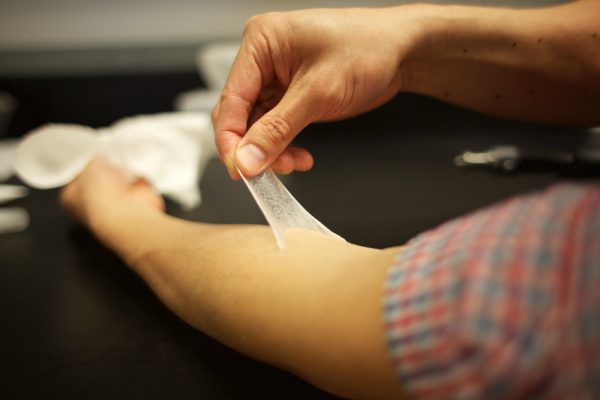
To join the scientific world together, PIMI Portal is re-publishing the post which has been published by an Iranian female scientist (Sepideh Niknezhad from Univ. of Ohio) at the linkedin, notifying the viewers that the same efforts has been going on at the Amir-Kabir Technical university under supervision of Dr. Hamid Mirzadeh.
Researchers from the MIT, the Massachusetts General Hospital, Living Proof and the Olivo Labs have created an innovative material with the ability to temporarily protect and tighten skin, and also smooth out wrinkles. With further development, the material could be used to deliver drugs to assist in the treatment of skin diseases such as eczema and other kinds of dermatitis.
The material is a silicone-based polymer that can be spread on the skin as a thin, undetectable coating. When applied on skin, its elastic and mechanical properties resemble that of a youthful and healthy skin. Upon investigations involving human subjects, the scientists discovered that the material had the potential to reshape “eye bags” below the lower eyelids and can improve skin hydration as well. According to the scientists, such a “second skin” can be adapted to offer long-lasting protection from harmful ultraviolet rays.The polymer was described in a paper published online in the journal Nature Materials on 9 May. Anderson is one of the authors of the paper, and Robert Langer, the David H. Koch Institute Professor at MIT and a member of the Koch Institute, is the senior author of the paper. Betty Yu SM ’98, ScD ’02, former vice president at Living Proof is the lead author of the paper. Langer and Anderson are respectively co-founders of Living Proof and Olivo Labs. Yu earned her master’s and doctorate from MIT.
Mimicking skin
Due to aging, skin turns less elastic and less firm, which can be aggravated by exposure to solar rays. This hinders the ability of the skin to protect against toxins, radiation, extreme temperatures, microorganisms and injury. Nearly a decade ago, the researchers aimed to create a protective coating with the ability to rehabilitate the characteristics of a healthy skin, for cosmetic as well as medical applications.
The research team produced a library of over 100 prospective polymers which has a chemical structure termed as siloxane. Siloxane contains a chain of interspersed atoms of oxygen and silicon. The polymers can be arranged in the form of a network called a cross-linked polymer layer (XPL). Then, the research team investigated the polymers in search of one that would best mimic the appearance, elasticity and strength of skin.
“It has to have the right optical properties, otherwise it won’t look good, and it has to have the right mechanical properties, otherwise it won’t have the right strength and it won’t perform correctly,” explained Langer.
The elastic properties of the best-functioning polymer will be very close to that of a healthy skin. During investigations in the lab, the polymer was stretched to over 250% and was observed to easily attain its original form. It should be noted that natural skin can be stretched to nearly 180%. The new XPL’s elasticity was found to be superior to two other kinds of wound dressings, namely, polyurethane films and silicone gel sheets, used at present on skin.
Please read more from the Source












